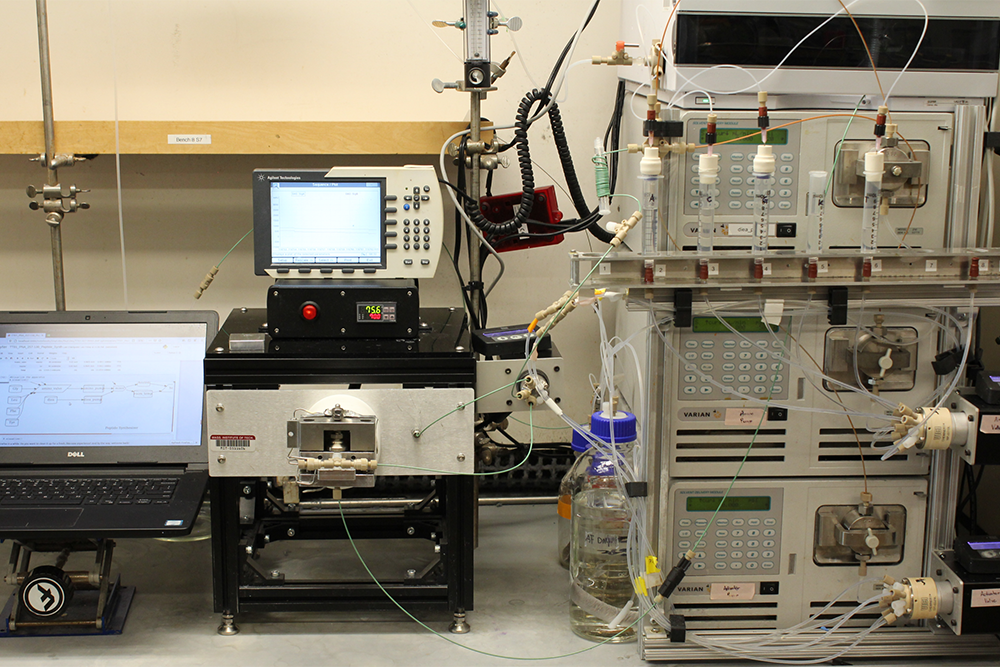Synthesis too slow? Let this robot do it.
Tiny Tides is an automated fast-flow instrument that can synthesize peptide-nucleic acids in a single shot.
Researchers in the lab of Bradley Pentelute, MIT Professor of Chemistry, have invented a fully automated fast-flow instrument that can synthesize peptide-nucleic acids in a single shot.
By automating the process of synthesizing CPP-conjugated peptide-nucleic acids (PPNAs) using the robot dubbed “Tiny Tides” by the research team, typical PPNA synthesis time was reduced from multiple days to just two hours.
“This new efficient technology represents a potential major step forward to enable on-demand rapid production of candidate antisense oligonucleotides, not only for Covid-19 but also for other diseases and emerging pathogens,” says Chengxi Li, a co-author of the paper and a postdoc in the Pentelute Group.
The paper, “Automated Flow Synthesis of Peptide−PNA Conjugates,” was recently published in ACS Central Science.
What are PNAs?
PNAs are artificially synthesized DNA-like molecules with a wide range of chemical and biological applications, emerging as a class of therapies being used to treat various diseases from cancer to viral infections. Barriers to PNAs becoming a drug include low solubility, poor cellular uptake, and rapid elimination.
Some of these challenges have been addressed with the covalent attachment of cell-penetrating peptides (CPP) to a PNA. However, CPP-conjugated PPNAs can be toxic to cells and often require time-consuming structure-function studies to minimize toxicity while optimizing delivery. In addition, although standard batch protocols allow for efficient access to PNA sequences of fewer than 15 bases, longer sequences are challenging to synthesize and face limitations that can result in low yields.
“Let the robot do it”
The automated fast-flow device, designed by the Pentelute Group to replace traditional stepwise synthesis via click chemistry, consists of seven modules including a central control computer, solution storage system, three HPLC pumps, three multiposition valves, heating elements, reaction zone, and a UV-vis detector — all controlled by a modular script in the Mechwolf programming environment.
The research team decided on the name Tiny Tides for two reasons: their robot makes peptides or oligonucleotides, and is a micro-scale synthesizer capable of rapid condition optimization and synthesis using a low amount of reagent and solvent, a comparatively tiny cost.
Despite the moniker, performance is anything but tiny. In lab tests, Tiny Tides reported 10 seconds for each amide bond formation between PNA monomers — compared with 10 minutes per amide bond for microwave peptide synthesizers; or 32 minutes per coupling cycle as with the DNA synthesizer Expedite 8909 capped at room temperature. Tiny Tides’ variable temperature design also eliminates the need for temperature capping, while increasing coupling efficiency.
This production strategy is convenient for simultaneous investigation of the bioactivity, toxicity, and cell uptake of multiple PNAs. In addition, the speed and automation of this device allows for a high throughput investigation of multiple candidates to find the most effective PNA sequence for a target, with significantly improved speeds over current and commercial methods.
Fight against Covid-19
While breakthroughs in vaccine science have taken center stage in the global Covid-19 pandemic, direct-acting antiviral agents could be another tool to eliminate this virus. In the lab, PNAs have demonstrated efficacy against SARS-CoV; and the high sequence similarity to SARS-CoV-2, the virus that causes Covid-19, has led researchers to believe that antisense PNAs may well be a way to achieve SARS-CoV-2 inhibition.
Speed and efficiency in synthesizing PPNAs is a much-needed step toward being able to evaluate the numerous possible sequences for viability in treating disease. For this study, the Pentelute group chemically synthesized eight PPNAs to combat Covid-19 in just one day — a feat which would have taken nearly a month if synthesized manually at a rate of two per week using previous methods.
Of the eight, one sequence eliminated over 95 percent of the virus in a live infection assay.
Other contributing authors are affiliated with MIT and Iowa State University.





